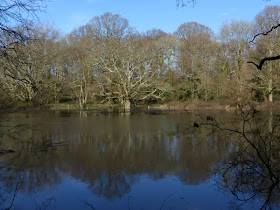Following my first mothing session of the year on the 20th February, I have put the trap out on several other occasions this week. The species list has been steadily growing, as have the numbers of individuals. On the 23rd February I caught 22 moths, 19 of which were Common Quakers, with single Clouded Drab, Chestnut and Satellite making up the supporting cast. On the evening of the 25th February the temperature dropped and resulted in just five Common Quakers, and single Chestnut and Satellite.
 |
| Acleris literana |
The trap at work has also gone out this week and overnight on the 26th Feb 16 moths were caught, 13 Common Quaker, an Oak Beauty, Grey Shoulder-knot and the micro moth Acleris literana. A. literana historically was found in one classic locality in the county of Hampshire, the New Forest, but in recent years it has turned up in small numbers in the south of the County after hibernation. It is single brooded with adults recorded from mid-July until May, hibernating through the winter as the individual above has no doubt done. The species is apparently very variable, but this individual is perfectly camouflaged for resting on lichen. A literana is not a species that I remember encountering before you have to admit it is a cracking moth that looks just like a miniature Merveille du jour.


















